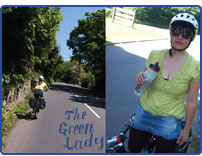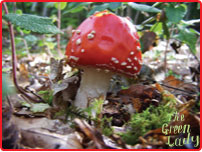 |
| At the Benmore Botanic Gardens within Argyll Forest Park. |
Friday, October 4, 2013
From Hastings to Glasgow
The Green Lady Hastings has now become The Green Lady Glasgow you can view my new site HERE.
Tuesday, July 2, 2013
The Cuckoo Trail in June
 |
| Under the bridge |
 |
| Past the river |
 |
| Over the bridge |
 |
| Past the wild strawberries |
 |
| Past the bluebell woods |
 |
| Past the wild garlic |
 |
| Under the blossom trees |
 |
| Past the pink campion |
 |
| On and on... |
We have been taking time to get outdoors and relax whenever we can. Here are a set of photos from the beginning of June of our second visit this year to The Cuckoo Trail. I would have loved to have heard the song of the cuckoo this time but unfortunately I didn't. Sadly the cuckoo is now on the official list of the UK's most endangered birds. The RSPB do a great job monitoring our birds, raising awareness and campaigning. I wrote about our first visit to the Cuckoo Trail when the birds were just starting to nest here. Many people locally know about Bedgebury which is an amazing place to visit for cycling but not many know about the Cuckoo Trail. Cycling the Cuckoo Trail is very different from cycling through the woods because you are on a mostly straight path which used to be the old railway track.
We parked for free and set off from Hellingly which is funny because you couldn't be further away from hell. The trail is very quiet though you will pass other cyclists and the occasional horse rider or walker. On this day everyone we passed was happy and friendly. How lovely having people we didn't know acknowledge us and wish us well. I thought about the contrast between this journey and the swarming bodies in shopping centres trying to avoid each other. We travelled gently up hill to Horam where we stopped at Wessons biker cafe which was packed with cyclists and bikers. Having refueled with coffee and cake (us) and ice cream (the boy) we took off downhill back to Hellingly. My six year old managed the nine mile round trip without a problem. Until the very end when we were a few feet from our car when he fell in some nettles getting off his bike. Whatever stresses, strains and stings life throws at us, a day out like this is the medicine needed to get up, brush ourselves off and carry on.
Sunday, May 26, 2013
Wednesday, May 8, 2013
Bateman's: Jacobean house, home of Rudyard Kipling
A couple of weeks ago the National Trust held a special
weekend where you could visit many of their properties for free. My husband
decided we should visit Bateman’s the home of Rudyard Kipling. We set off on a
chilly spring day and travelled back in time to the place that had also
reconnected Kipling to the history of England and the “things that were
underneath” according to TS Eliot, “a deepening of the imperial into the
historical imagination". From striving outwards to looking within. A refuge from the trippers who besieged his Rottingdean
house and an escape from the reminders of his six year old daughter’s tragic
death from pneumonia, Bateman’s and the Dudwell valley would shape the second
half of his life’s work.
We strolled through the wildflower meadow that spreads
along the banks of the river Dudwell. Dappled sunlight shone on splashes of blue,
white, purple and yellow of the scillas, wood anemones, fritillaries and
daffodils that decorated the long, tangled grass. In the formal garden my son counted the
number of newts slowly appearing in the murky pond water with increasing excitement. Kipling had designed
this area himself making sure the pond had a shallow concrete bottom
so that a child or anyone else falling in would come to no harm. Since our
visit I have started reading Puck of Pook’s hill, a story written for his children
about a spirit, “the oldest Old Thing in England” who appears in the wild
garden to teach them about the history of England.
As Kipling was to write almost at the end of his life, with amazement and gratitude at what this landscape had given him:
As Kipling was to write almost at the end of his life, with amazement and gratitude at what this landscape had given him:
“The Old Things of our valley glided into every aspect of
our outdoor works. Earth, Air, Water and People had been – I saw it at last –
in full conspiracy to give me ten times as much as I could compass, even if I
wrote a complete history of England, as much as that might have touched or
reached our valley.”
The magic, the things that are underneath, the healing and wonder are
always there if you know where to look. It is the right of every human to experience
and must be protected for our future.
PUCK'S SONG
See you the ferny ride that steals
Into the oak-woods far?
0 that was whence they hewed the keels
That rolled to Trafalgar.
Into the oak-woods far?
0 that was whence they hewed the keels
That rolled to Trafalgar.
And mark you where the ivy clings
To Bayharn's mouldering walls?
0 there we cast the stout railings
That stand around St. Paul's.
To Bayharn's mouldering walls?
0 there we cast the stout railings
That stand around St. Paul's.
See you the dimpled track that runs
All hollow through the wheat?
0 that was where they hauled the guns
That smote King Philip's fleet.
All hollow through the wheat?
0 that was where they hauled the guns
That smote King Philip's fleet.
(Out of the Weald, the secret Weald,
Men sent in ancient years,
The horse-shoes red at Flodden Field,
The arrows at Poitiers!)
Men sent in ancient years,
The horse-shoes red at Flodden Field,
The arrows at Poitiers!)
See you our little mill that clacks,
So busy by the brook?
She has ground her corn and paid her tax
Ever since Domesday Book.
So busy by the brook?
She has ground her corn and paid her tax
Ever since Domesday Book.
See you our stilly woods of oak,
And the dread ditch beside?
0 that was where the Saxons broke
On the day that Harold died.
And the dread ditch beside?
0 that was where the Saxons broke
On the day that Harold died.
See you the windy levels spread
About the gates of Rye?
0 that was where the Northmen fled,
When Alfred's ships came by.
About the gates of Rye?
0 that was where the Northmen fled,
When Alfred's ships came by.
See you our pastures wide and lone,
Where the red oxen browse?
0 there was a City thronged and known,
Ere London boasted a house.
Where the red oxen browse?
0 there was a City thronged and known,
Ere London boasted a house.
And see you, after rain, the trace
Of mound and ditch and wall?
0 that was a Legion's camping-place,
When Caesar sailed from Gaul.
Of mound and ditch and wall?
0 that was a Legion's camping-place,
When Caesar sailed from Gaul.
And see you marks that show and fade,
Like shadows on the Downs?
0 they are the lines the Flint Men made,
To guard their wondrous towns.
Like shadows on the Downs?
0 they are the lines the Flint Men made,
To guard their wondrous towns.
Trackway and Camp and City lost,
Salt Marsh where now is corn-
Old Wars, old Peace, old Arts that cease,
And so was England born.
Salt Marsh where now is corn-
Old Wars, old Peace, old Arts that cease,
And so was England born.
She is not any common Earth,
Water or wood or air,
But Merlin's Isle of Gramarye,
Where you and I will fare.
Water or wood or air,
But Merlin's Isle of Gramarye,
Where you and I will fare.
Friday, March 29, 2013
Going wild at school
 |
| Green and red dogwood decorating the rustic fence and made into a wreath with some willow. |
 |
| The wildlife area. The tree supports a huge mass of ivy which is a perfect nesting site. |
 |
| Bundles of dogwood cuttings for the children to play with on the left, cuttings that I later planted on the right. |
 |
| Red dogwood and willow stems. |
 |
| Bundles of sticks to attract insects. |
 |
| A willow arch that I pruned and tidied up and the primroses and daffodils planted by the children. |
Previously when I've worked here I've had small groups of children come out to help. Then at play time and lunch time I had kids swarming round me desperate to do something and I would try and find jobs for as many as possible without creating total chaos. Their enthusiasm should be encouraged. This time I wanted to work alone so that I could get a number of jobs finished quickly. Ideally the children would have complete control of the garden by training up some to oversee regular maintenance jobs. Unfortunately there is still an attitude that the garden is a special out of bounds place. My son told me "we're not allowed in there". I hope the attitude of staff changes but it may take some time and gentle encouragement.
My first job was cutting back a red-barked, leggy, neglected dogwood bush: Cornus alba 'Sibirica'. They should be pruned just before they bud in March/April. I pruned the dogwood to about 4" from the ground and saved as much of the bright red stems as I could. The new shoots are needed for the beautiful burning colour.
Why do I love dogwood so much? I love to use natural, sustainable materials in craft projects and dogwood is just perfect for this. You can make fences, wreaths, baskets, stars, picture frames. The stems are incredibly soft with an almost rubber quality to them which will bend and wrap easily. A perfect shrub for school grounds, if there are enough of them you can be harvesting big bundles of stems to use as part of the outdoor learning experience. Along with the green-barked variety (Cornus stolonifera 'Flaviramea') and willow plantings you will have a variety of stems that can be used cut and also rooted in the ground for living structures and sculptures. Soak the cut stems in water for a while if they become too stiff to use. Dogwoods are often planted by councils in parks and next to roadsides (they are incredibly tough) so you can harvest your craft materials for free. As long as you use sharp secateurs and don't take too much. Always cut just above a bud.
They are also easy to propagate to create more plants. Cut stems that are about a pencil thick just below the nodes (where the leaves grow from the stem) at the bottom and just above the nodes at the top. Cut the top on a slant so you know this is the top when planting. Stems should be roughly 10-12" long. Plant the cuttings up to 2/3 deep in some moist, well drained soil. They need to go in this deep to stop wind damage. Plant about a foot and a half apart. I was very lucky to get a bundle of cuttings all ready prepared for me (like on a TV show) by the lovely Tony, head gardener at Fairlight Hall.
When working at a community garden or school garden It really helps to befriend people who are working on large gardens and estates because it's amazing the amount of re-usable vegetation they will create or spare plants and seedlings they will have and will often be happy to donate. Ideally there would a connection between the council, schools, community gardens and estates. A number of jobs could be created and it would save lots of money.
I planted the cuttings in a circle in the field while flecks of snow were falling like little white feathers. Then covered them with the bark chippings I persuaded the council to deliver. It is a water-logged area of the field. I plan to buy some willow whips to add to the circle. This extended winter weather has bought me some extra planting time which is great.
I have also finished the grant application which will be sent in this week to the Big Lottery. Please keep your fingers crossed for us. It would enable the school to renovate woodland that at the moment is closed off by a large fence and has rubbish thrown into it and has been used for drug taking. When I was at school I remember looking through the playground fence to a marshy wooded area that had little wooden paths through it. I don't ever remember being allowed to go there and I longed to be able to play there. Thirty years later not much has changed with most school playgrounds. I was lucky that I was taken to the woods and countryside regularly by my parents and when I was older was able to play unsupervised in woods near my house. Very few children have this experience now.
At playtime a boy asked what I was doing. I showed him the wreath I was making then showed him how to do it. I left a bundle of cuttings for the children to come and find on their own and told the boy to show his friends how to make the wreaths. When I visited a few days later I noticed the stems had been disturbed and there were a few new wreaths. Evidence that the children are feeling more at home in the wildlife area too.
For further information on creating a wildlife garden visit the RSPB's page here: wildlife friendly gardens.
Here is another great resource with lots of advice for encouraging wildlife: wildlife gardening pack.
Sunday, February 17, 2013
What You Could Have
In 2011 the plan was continuing and a booklet was produced letting us know that "over the next year we will build a path for pedestrians and cyclists along the beach between Bexhill and Hastings through the coastal part of the proposed park". There was a year long list of events at Pebsham Countryside Park including a farm walk, a dawn chorus walk, Filsham Reedbed open day, photography walk, bug hunt and forest school taster day. This continued in 2012 with volunteer days at Filsham Reedbed up until 15th December 2012, just a week before trees trees started to be felled. The park had a new name for a "new era" Combe Valley Countryside Park. There was even a Children's Poetry Competition: "Put pen to paper in celebration of our local countryside and join us in the exciting launch of Combe Valley Countryside Park! The park that links Bexhill, Hastings and Crowhurst!" The last time there was a public consultation about the road was in 2004, long before the work to promote and develop the Countryside park began.
One week before Christmas 2012 work began to build a road through Combe Valley Countryside park. Contractors moved in to fell trees along the railway line. Local residents were informed the works would start in January. The ancient, peaceful land will be changed forever and there is no talk of the Countryside Park anymore. Instead, Councillor Peter Jones, head of East Sussex County Council says the people of East Sussex want the road and he wished everyone else would "shove off" and let them get on with it. This included the leaders of six national environment groups who visited the site on 27th January calling for the work to stop.
One of the reasons I love Hastings is because there are a number of beautiful Nature Reserves here. These have been spared the developer's bulldozers because Hastings is a bit of a hidden town, with a reputation for being a dump, at the end of the train line. There aren't very many wild places left in England. Over the years with support from groups like the Wildlife Trust these areas have been looked after and developed to make them useable by everyone in the community. A whole industry of environmental projects could be set up here with the support of anyone with the intelligence to see that: improved education, arts, physical and mental health, tourism, leisure and the jobs this could create. None of the local schools are making use of the Nature Reserves. Let's not forget the wildlife that is being supported, from a booklet published by Hastings Borough Council in 2004: "much of which is rare and endangered". Over 20 different species of dragonfly have been recorded within Combe Haven Valley including the rare Hairy Dragonfly and Ruddy Darter. It is a Site of Special Scientific Interest designated due to its importance to nature conservation NATIONALLY.
The old railway line that could have become a cycle path leading to a community farm and shop and country pub will be replaced by a road. The trees have been felled already even though the Department of Transport have not yet approved the building of it. This is the first of hundreds of roads proposed in England and Wales by a Government who's austerity cuts have made thousands unemployed, threaten the future of the NHS, have resulted in rises of mental illness, suicide and domestic violence and have failed to get the country out of the recession.
Today it all seemed like it could be another world. My family and I cycled along the cuckoo trail which is a 20 mile drive from Hastings. The 14 mile former railway line was busy with people of all ages walking, cycling, horse riding, smiling, chatting to strangers. It's a place where birds play chicken, flitting across the path in front of our bicycles. We saw a fox quickly run and hide from us. The sound of bird song drowned out the distant traffic. I recently heard on a radio programme that birds in urban areas are singing at night instead of the daytime because they can't compete with the noise of the city. In a pub on the trail the owner said it's packed in the summer months. It was pretty busy today, despite the February chill. We need safe places like this that can be enjoyed by every member of the family.
Following the advice from Hastings Borough Council, East Sussex County Council, Rother Council and 1066 Country who funded the 2012 Combe Valley Countryside Park booklet:
"Make the most of Hastings' parks and countryside, learn more about its wildlife and contribute to its protection and preservation". A number of people, many of them elderly, have been arrested for doing just that.
 |
| Cuckoo Trail and Pebsham Countryside Park Project information. |
PLEASE SIGN THE PETITION TO STOP THE ROAD: HERE
Subscribe to:
Posts (Atom)





























































